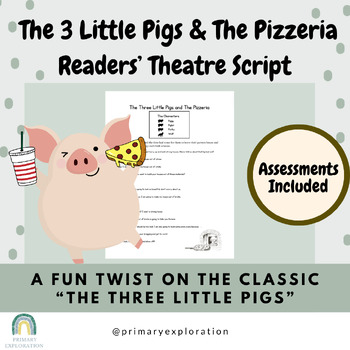The Three Little Pigs and The Pizzeria Readers' Theatre Scripts and Assessments
- PDF
Description
The Three Little Pigs and The Pizzeria Readers' Theatre Scripts and Assessments is a fun and happier twist on the classic tale "The Three Little Pigs". This drama script was designed for students in Primary (Grade 1, Grade 2, Grade 3), however, this script could also be used for students in the Junior grades as well (Grades 4 - 6).
In addition to The 3 Little Pigs and The Pizzeria Drama Script, you will also have access to: a customizable Letter to Parents, Student Planning Sheet, Student Drama Reflection Sheets, Anecdotal Note options to take ongoing assessments, reading extension activities, as well as multiple Rubric options to evaluate the final performance. This fun Readers' Theatre Package is print and go ready, and will walk students through the process of a successful drama/literacy unit.
All of the characters in the readers' theatre script are written as gender-neutral. This choice was made deliberately to simplify role assignments for educators, eliminating concerns about gender-specific roles (ie: "boy" characters to girls, and vice versa). Each script is meticulously designed to accommodate various reading levels, featuring straightforward sentences and focusing on commonly recognized sight words.
You could use The Three Little Pigs and The Pizzeria Readers' Theatre Scripts and Assessments for both small or large lessons/activities by having groups practice for a particular role, or as a small centre by having students come read and act out the script and bring it to life! This is the perfect drama assessment activity that your students will LOVE, and that will come with no planning on your end!
The Three Little Pigs and The Pizzeria Readers' Theatre Scripts and Assessments was designed with ease in mind for Kindergarten, Grade 1, Grade 2, and Grade 3 students, Elementary teachers and educators!
The Three Little Pigs and The Pizzeria Readers' Theatre Scripts and Assessments includes:
- Title Page
- Thank You Page
- Letter to Parents
- The Three Little Pigs and The Pizzeria Script (9 Pages)
- 4 Reading Extension Activities
- My Performance Plan
- 2 Anecdotal Notes Options
- 2 Self-Reflection Options
- 2 Rubric Final Assessment Options
How I Use The Three Little Pigs and The Pizzeria Readers' Theatre Scripts and Assessments in my Classroom:
This Readers' Theatre is based off of the classic story, "The Three Little Pigs". The 3 Little Pigs is a story about three pigs building houses. A wolf tries to blow them down to eat the pigs, but only the house made of bricks withstands his efforts. I really like that this script, "The Three Little Pigs and The Pizzeria" has a happier twist and contains a message about problem solving and enrtrupeiership. I love using the three little pigs with my grade 3s, when we are working on the science unit, structures. It makes for a nice cross-curricular moment between, literacy, drama, and science when we talk about strength, stability, and materials for various structures. This script has the spot for 4 formal characters, so I typically arrange my students in groups of 4. However, if I have also been able to modify the script a tad so that I could have 5 or even 6 characters by having some narrators. I have always found this script is easy to follow and can be suited for any primary reading type.
As soon as the scripts are given, I hand out the Parents Letter so parents are aware students will be practicing during class time and are encouraged to also practice at home.
After students have chosen/been given their roles, I have them complete the student planning sheet. They can think critically about what words they want to emphasize during the performance, think of gestures and actions, etc, so that they can be successful.
During class practice time, I am keeping close tabs on my students' progress with my anecdotal note tracker. (In this download, I give you two options. I personally prefer using the first option.)
I assess group performances by completing individual rubrics for each student. (I like using the second rubric option that is provided in this download). There are times when we have done additional performances by inviting parents to watch the final performances, a neighbouring class, or our reading buddies. I'm not a fan of assessing while there are outside classroom visitors, so I make sure the assessments are done beforehand.
You Might Be Interested In
3 Friendship Readers' Theatre Drama Scripts and Assessments for Primary
Reader's Theater Pack- Goldilocks And The Three Bears - Grade 1, 2, 3, 4, Rubric
Winter Readers' Theatre Drama Scripts and Assessments for Primary
Build A Classroom Community Activity Bundle
Reading Comprehension Passages & Questions for Primary: Fiction and Non-Fiction
Hey, Let's Connect!
Primary Exploration on Linktree
Primary Exploration on Instagram
Primary Exploration on Pinterest
❤️ Love ❤️ Freebies and Discounts?
Be the first to know about all my new products, freebies, and discounts by clicking on the green star next to my store logo. Click it to become a Primary Exploration follower and receive updates about my Teachers Pay Teachers store.





